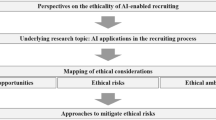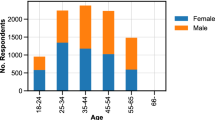Abstract
This paper demonstrates that the positiveness and negativeness of letters of acceptance and rejection from companies have an impact on company image, self-concept of recipient, and reported future intentions of potential recruits. The implication for employers writing letters of acceptance and rejection is that they should communicate with prospective recruits in a positive manner no matter what the letter's message. Positive rejection letters can mitigate effects of rejection and negative acceptance letters can impair the positiveness of acceptance.
Similar content being viewed by others
References
Campbell, Kim S. 1990. “Explanations in Negative Messages: More Insights From Speech Act Theory.”Journal of Business Communication. 27: 357–375.
Cox, A. 1983. “Cox Report 1: If Your Corporation Were An Animal, What Animal Would It Be?”Across the Board. 20: 17–20.
Day, C.R., Jr. 1980. “Do Companies Have Personalities?”Industry Week. 205: 72–78.
Deutsch, A.R. 1981. “Recruiting and Communications Part Two: Beyond Advertising.”Journal of College Placement. XLI: 53–55.
Feinberg, R., J. Meoli, T. Snuggs, and L. Levandowski 1985. “Rejection Letters and Retail Corporate Image.” InRetailing. Theory and Practice for the 21st Century. Ed. R. King. Charleston, West Virginia: Academy of Marketing Science.
Fielden, J.S. and R. Dulek 1982. “What Rejection Letters Say About Your Company.”Business Horizons. 25: 40–45.
Gray, E. and L. Smeltzer 1985. “Corporate Image—An Integral Part of Strategy.”Sloan Management Review 26: 73–78.
Hagge, J. 1989. “The Spurious Paternity of Business Communication Principles.”Journal of Business Communication. 26: 33–55.
Jones, E., D. Kanouse, H. Kelley, R. Nesbett, S. Valins, and B. Werner 1972.Attribution: Perceiving the Causes of Behavior. New Jersey: General Learning Press.
McManus, M.L. 1979. “Remedy for a Poor Organizational Image.”S.A.M. Advanced Management Journal. 44: 31–40.
Stancill, J.M. 1984. “Upgrade Your Company's Image-and Valuation.”Harvard Business Review. 62: 16–18.
Wilkinson, C., Wilkinson, D., & Vik, G. 1986.Communicating Through Writing and Speaking in Business. 9th Edition. Homewood, IL: Richard Irwin.
Worchester, R. 1972. “Corporate Image Research.” InConsumer Marketing Research Handbook. Ed. R. Worchester. New York: McGraw Hill Book Company.
Author information
Authors and Affiliations
Additional information
This research was partially supported by Grant #82037 from the Purdue Agricultural Research Station. Reprints should be addressed to Dr. Richard Feinberg, Department of Consumer Sciences and Retailing, Purdue University, 1262 Matthews Hall, West Lafayette, IN 47907-1262.
Rights and permissions
About this article
Cite this article
Feinberg, R.A., Meoli-Stanton, J. & Gable, M. Employment rejection and acceptance letters and their unintended consequences on image, self-concept, and intentions. J Bus Psychol 11, 63–71 (1996). https://doi.org/10.1007/BF02278256
Issue Date:
DOI: https://doi.org/10.1007/BF02278256




